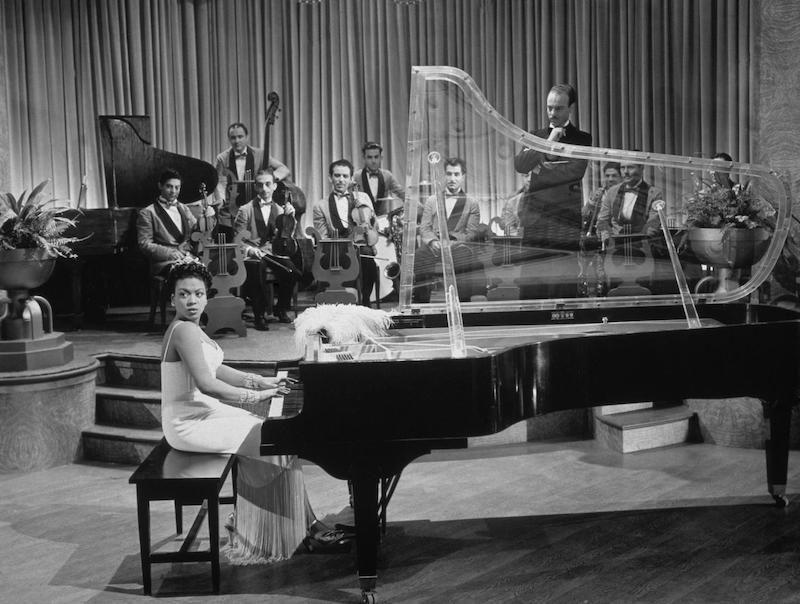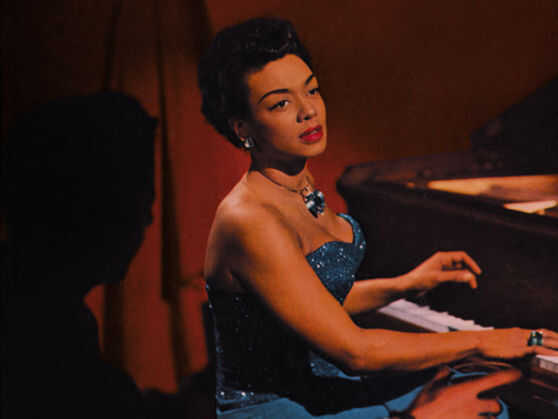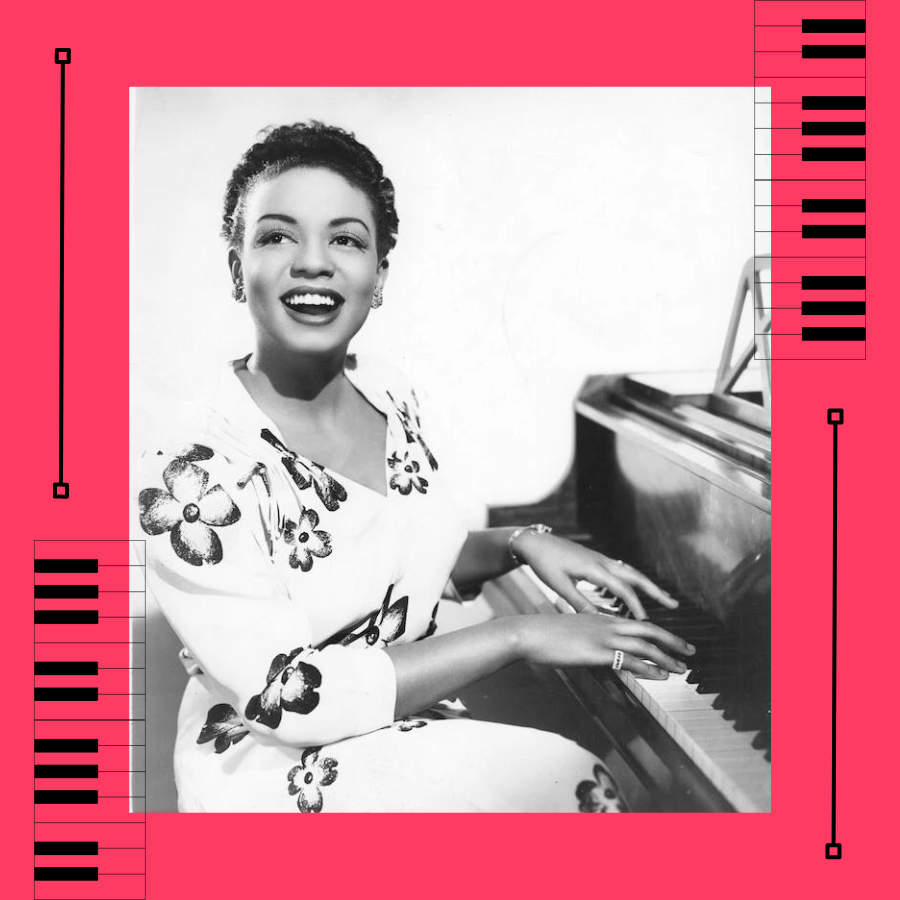“Reclaiming the Canon” is a series of posts that aims to bring attention to historical women who are often excluded from the narrative of their field — whether in literature, music, science, or other areas. Each post features a woman whose name we feel everyone should know. Readers are strongly encouraged to explore further resources, spend quality time with primary sources when possible, and self-educate — because re-claiming the canon starts with you!
This post may include affiliate links, which means we make a small commission on any sales. This commission helps Feminist Book Club pay our contributors, so thanks for supporting small, independent media!
Who Was Hazel Scott?
Hazel Scott was an American jazz and classical pianist who grew up in Harlem and lived from 1920-1981. A child musical prodigy, she studied with a Juilliard professor on a scholarship by the age of 8 and already had an active performing career in her teens—earning herself a reputation as the “hot classicist.” She was an active jazz pianist and singer throughout the 1930s and 1940s, and she performed in five Hollywood films. In 1950 she became the first Black American to host her own TV show, The Hazel Scott Show. Scott performed throughout Europe in the 1960s before returning to the United States in 1967.
As one of the most famous Black entertainers of the mid-20th century, Hazel Scott leveraged her position in the spotlight to bring attention to civil rights issues. As a musician, she was an incredibly virtuosic pianist, known for her unique style of “swinging the classics.” For example, her performance of Liszt’s Hungarian Rhapsody No. 2 (or something like it!):
Her Life
Hazel Scott was born in Trinidad to two distinguished parents. Her father was a West African scholar from Liverpool, England and her mother was a classically trained pianist. The family moved to Harlem when young Hazel was only four years old, and by that time it was clear to everyone that she was a musical prodigy. As a kid, Hazel Scott lived with her mother and grandmother after her parents separated. Art Tatum and Billie Holiday were two of many prestigious family friends who regularly visited the Scott household and influenced young Scott’s musical style.
When Hazel Scott was only 8 years old, she began studying music at Juilliard. Her mother Alma Long Scott was an accomplished musician as well, and in 1933 she organized her own Alma Long Scott’s All-Girl Jazz Band, in which 13-year-old Hazel played piano and trumpet. Hazel Scott quickly developed a popular musical reputation both on the radio and in New York City nightclubs, including at Café Society, which was the first racially integrated night club in the United States. By the time she was 25 years old, Scott was earning today’s equivalent of over one million dollars per year. That same year, she married New York Congressman Adam Clayton Powell. They had one child together before their divorce about a decade later.

Hazel Scott’s prowess as a musical entertainer soon caught the attention of Hollywood. Because Scott refused to play any stereotypical “singing maid” roles, she turned down the first four roles that were offered to her. She would go on to perform in five movies only as herself, wearing her own clothes and jewelry to retain control over her image. She also refused to perform in segregated venues when she toured throughout the United States, and was even forced to leave the entire city of Austin, Texas for this reason.
The Hazel Scott Show started in 1950, which was unfortunately the same year Scott testified before the House Un-American Activities Committee during McCarthyism (a fear of the rise of communism that publicly targeted many entertainment professionals). Her career faltered as a result, and she moved to Paris a few years later to avoid the political fallout. Scott spent a decade performing throughout Europe, and she did not abandon her outspoken support of civil rights. In 1963 she marched with other African-American expatriates, including James Baldwin, to the United States Embassy in Paris in solidarity with the upcoming March on Washington. After she returned to the United States in 1967, she occasionally performed and appeared on television until her death in 1981.

Her Contribution
Hazel Scott’s most highly regarded record was her 1955 album Relaxed Piano Moods, recorded two years before she left America for Paris. She also performed at Carnegie Hall and soloed with the New York Philharmonic and the Philadelphia Orchestra, among others. As the first Black woman to host her own TV show, she was a beloved entertainer who brought her beautiful and resolute voice to the civil rights movement.
Hazel Scott always used her status to bring attention to racial injustice and civil rights, and she boldly stood up to media and government machines alike. After her death in 1981, she was buried at Flushing Cemetery near other jazz greats including Louis Armstrong and Dizzy Gillespie. More recently, when Alicia Keys performed at the 2019 Grammy Awards, she cited Scott as one of her inspirations: “Shout-out to Hazel Scott, I’ve always wanted to play two pianos.”
In Her Words
Hazel Scott was known for going to great lengths—both in her personal and political life—to spread the message that Black people should always be presented in a dignified fashion. As recalled by her son, Adam Clayton Powell III, Hazel Scott told him later in life:
“You understand, your mother was a holy terror. There were just some things that I would insist on doing. And some people would say, ‘Oh, you know, it hasn’t been done.’ Of course it hasn’t been done. Nothing has been done.”
-Hazel Scott, as remembered by her son in Jennifer Keishin Armstrong’s When Women Invented Television
Further Resources
Karen Chilton wrote the biography Hazel Scott: The Pioneering Journey of a Jazz Pianist from Café Society to Hollywood to HUAC.
The official Hazel Scott website has a fantastic page of audio resources, including both music by and interviews with Hazel Scott.
Jennifer Keishin Armstrong’s When Women Invented Television tells the stories of TV pioneers Irna Phillips, Gertrude Berg, Hazel Scott and Betty White.
For kids (ages 9-12) check out Hazel Scott: A Woman, a Piano, and a Commitment to Justice.
Learn more about Hazel Scott on the Library of Congress blog.


